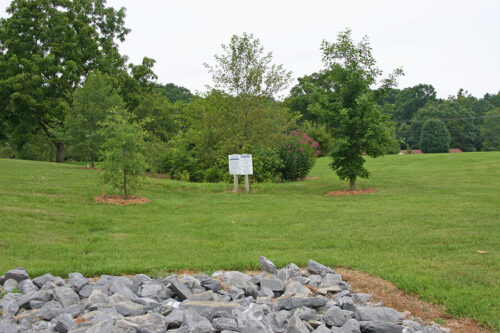 A rain garden is just what the name implies – a garden with native plants that can capture the first flush or runoff from a rain event. Rain gardens can have layered vegetation, including canopy, understory, and groundcover plants.
A rain garden is just what the name implies – a garden with native plants that can capture the first flush or runoff from a rain event. Rain gardens can have layered vegetation, including canopy, understory, and groundcover plants.
By capturing this runoff in the rain garden, you will not only provide runoff reduction benefits, you may also provide neighborhood and community environmental benefits, such as:
- Increased vegetation mixture in your yard that provides habitat for insects and birds
- Enhanced beauty of your yard
- Increased groundwater renewal
Rain Gardens are Important
 Rain is an important occurrence in nature because it replenishes water supplies, provides moisture for living resources, and maintains flow levels of rivers and streams.
Rain is an important occurrence in nature because it replenishes water supplies, provides moisture for living resources, and maintains flow levels of rivers and streams.
But, in areas with human development, rain can have negative effects on the environment. Any surface pollutants will wash away with rain, flowing into the nearest waterway. Examples of less-desirable pollutants that are carried in stormwater runoff include petroleum products, animal waste, fertilizers, and pesticides.
The more impervious or water-resistant surfaces present in the landscape, the less rainwater that will infiltrate or penetrate into the soil and recharge groundwater supplies. In altered or urban landscapes, the use of rain gardens and other bio-retention features like engineered wetlands and grassy swales can reduce the negative impacts of stormwater runoff from smooth, compact surfaces like streets and parking lots.
Municipalities and individual homeowners can mimic forested floodplains by installing bio-retention features, like rain gardens. See DOF’s comprehensive Rain Garden Technical Guide for specifics for locating, designing, and planting your future rain garden.
Additional Resources
| Image | Title | ID | Description | Date | Content Type | View | hf:tax:document-category | hf:tax:Media |
|---|---|---|---|---|---|---|---|---|
 | Rain Gardens: Technical Guide | P00127 | Technical guide provides detailed instruction for homeowners, teachers, community leaders, gardeners and landscape architects on the planning and development of rain gardens to create a landscape feature that will solve drainage problems, address erosion problems, improve water quality, create wildlife habitat and create a garden focal point. Printed copies available. | 05/01/2014 | Publication | View | urban-and-community-forestry water-quality | publication |
 | Rain Gardens | P00124 | Brochure educates landowners on options available to resolve issues with excess drainage from roofs, gutters, sidewalks, and roads, eliminating soil erosion, improving the quality of water, and how to put nature to work for you. Printed copies available. | 05/01/2012 | Publication | View | urban-and-community-forestry water-quality | publication |
Contact Us
For more information or questions, e-mail us or use our contact form.
